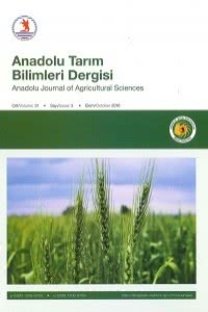Anamateryal ve arazi kullanım şeklinin topraktaki bazı mikroelement fraksiyonlarının dağılımına etkileri
Effects of parent material and land use on distribution of some trace elements fractions in soil
___
- Adriano, D. C., 1986. Trace Elements in the Terrestrial Environment. Springer-Verlag, New York.
- Black, C. A., 1965. Methods of soil analysis. Parts 1 and 2. Agronomy 9: 572-576, 671-698, 900, 1372-1375. Am. Soc. Argon. Madison, Wis.
- Chandi, K. S., Takar, P.N., 1982. Effects of agricultural cropping systems on micronutrients transformation. I. Zinc Plant Soil 69: 423-436.
- Coppenet, M., Golven, J., Simon, J. C, Lecorre, L., Leroy, M., 1993. Chemical evolution of soils in intensive animal-rearing farms. The example of Finistère. Agronomie 13: 77–83.
- Demiralay, İ., 1993. Toprağın Fiziksel Analizleri. Atatürk Üniversitesi Ziraat Fakültesi Yayınları, No: 143, Erzurum.
- Gessler, P.E., Chadwick, O.A., Charman F., Althouse, L., Holmes, K., 2000. Modelling Soil-Landscape and Ecosystem Properties Using Terrain Attributes. Soil Sci. Soc. Of Amer., J. 64:2046-2056.
- Heil, R. D., Mahmoud, K.R., 1978. Mean concentrations and coefficients of variation of selected trace elements of various soil taxa. pp. 198-213. In: Forest Soils and Land Use, C. T. Youngberg (ed.). Colorado State Univ., Fort Collins, CO.
- Iyanger, S.S., Martens, D.C., Miller, W.P., 1981. Distribution and plant availability of soil zinc fractions. Soil Sci. Soc. Am. J. 45: 735-739.
- Kacar, B., 1994. Bitki ve Toprağın Kimyasal Analizleri: III Toprak Analizleri. Ank. Ünv. Ziraat Fak. Eğitim Araştırma ve Geliştirme Vakfı Yay. No: 3, Ankara.
- Kubota, J. 1981. Role of soil survey trace element studies. pp. 177-186. In: Technical Monograph 1, Soil Research Inventories and Development Planning. Soil Conservation Service, USDA, Washington, D.C.
- Lal, R., 1988. Soil Erosion Research Methods. Soil and Water Conservation Society, pp: 141-149.
- Lund, L.J., Betty, E.E., Page, A.L., Elliott, R.A., 1981. Occurrence of naturally high cadmium levels in soils and its accumulation by vegetation. J.Environ. Qual., 10:551-556.
- Maskall, J.E., Thornton, I., 1998. Chemical partitioning of heavy metals in soils, clays and rocks at historical lead smelting sites. Water Air Soil Pollut. 108 (1998), pp. 391–409.
- Miller, W.P., McFee, W.W., Melley, J.M., 1983. Mobility and retention of heavy metals in sandy soils. J. Environ. Qual. 12: 579-584.
- Munro, R.D., 1983. Environmental research and management priorities for the 1980s. Ambio 12:61–62.
- Page, A.L., 1974. Fate and effect of trace elements in sewage sludge when applied to agricultural lands. Env. Protection Tech. Series EPA-670/2-74-005.
- Shuman, L.M., 1986. Effect of liming on the distribution of manganase, copper, iron and zinc among soil fractions. Soil Sci. Soc. Am. J. 50: 1236-1240.
- Sims, J.L., Patrick Jr W.H., 1978. The distribution of micronutrient cations in soil under conditions of varying redox potential and pH. Soil Sci. Soc. Am. J. 42: 258-262.
- Sims, J.T., 1986. Soil pH Effects on the Distribution and Plant Availability of Zinc, Manganese and Copper Soil. Sci. Am. 367-373.
- Soil Survey Staff., 1975. Soil Taxonomy. United States Department of Agriculture Handbook, 436, Washington, D.C.
- Sposito, G., Lund, L.J., Chang, A.C., 1982. Trace metal chemistry in arid-zone soils amended with sewage sludge. 1. Fractionation of Ni, Cu, Zn, Cd and Pb in solid phases. Soil Sci. Soc. Am. J. 46: 260-264.
- Walter, I., Cuevas, G., 1999. Chemical fractionation of heavy metals in a soil amended with repeated sewage sludge application. The Science of the Total Environment, Volume 226, Number 2, 9 February 1999, pp. 113-119(7).
- ISSN: 1300-2988
- Yayın Aralığı: Yılda 3 Sayı
- Başlangıç: 2018
Silindirik fındık depolama yapılarında depo yükü projeleme parametreleri
Alternatif yağ bitkisi: ketencik ICamelina sativa (L.) Crantz I
Toprak erozyonu çalışmalarında bulanık mantık uygulamaları
TUĞRUL YAKUPOĞLU, NUTULLAH ÖZDEMİR, İmanverdi EKBERLİ
Tütün atığının farklı bünyeli toprakların bazı kimyasal ve fiziksel özelliklerine etkisi
Silindirik mısır depolama yapılarında tane nem kapsamına bağlı projeleme yükleri
Turgut ÖZTÜRK, Bilge ESEN, HAKAN KİBAR
Karadeniz kıyılarında çift tekneyle çekilen ortasu trolü ile bazı pelajik balıkların avcılığı
NUTULLAH ÖZDEMİR, Elif ÖZTÜRK, TUĞRUL YAKUPOĞLU
Süt sığırlarında mastitis ile sütün elektiriksel iletkenliği arasındaki ilişkiler
